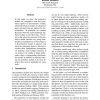Free Online Productivity Tools
i2Speak
i2Symbol
i2OCR
iTex2Img
iWeb2Print
iWeb2Shot
i2Type
iPdf2Split
iPdf2Merge
i2Bopomofo
i2Arabic
i2Style
i2Image
i2PDF
iLatex2Rtf
Sci2ools
EMNLP
2006
2006
Competitive generative models with structure learning for NLP classification tasks
In this paper we show that generative models are competitive with and sometimes superior to discriminative models, when both kinds of models are allowed to learn structures that are optimal for discrimination. In particular, we compare Bayesian Networks and Conditional loglinear models on two NLP tasks. We observe that when the structure of the generative model encodes very strong independence assumptions (a la Naive Bayes), a discriminative model is superior, but when the generative model is allowed to weaken these independence assumptions via learning a more complex structure, it can achieve very similar or better performance than a corresponding discriminative model. In addition, as structure learning for generative models is far more efficient, they may be preferable for some tasks.
| Added | 30 Oct 2010 |
| Updated | 30 Oct 2010 |
| Type | Conference |
| Year | 2006 |
| Where | EMNLP |
| Authors | Kristina Toutanova |
Comments (0)

